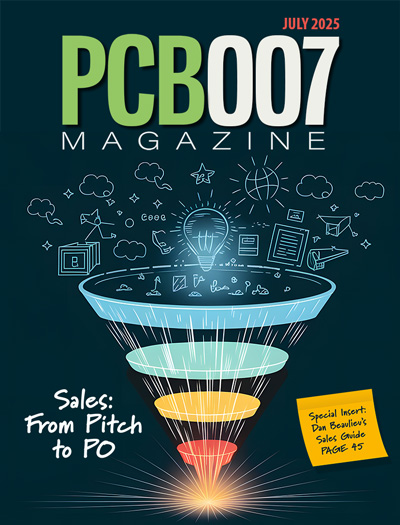-

-
News
News Highlights
- Books
Featured Books
- pcb007 Magazine
Latest Issues
Current Issue
Inventing the Future with SEL
Two years after launching its state-of-the-art PCB facility, SEL shares lessons in vision, execution, and innovation, plus insights from industry icons and technology leaders shaping the future of PCB fabrication.

Sales: From Pitch to PO
From the first cold call to finally receiving that first purchase order, the July PCB007 Magazine breaks down some critical parts of the sales stack. To up your sales game, read on!

The Hole Truth: Via Integrity in an HDI World
From the drilled hole to registration across multiple sequential lamination cycles, to the quality of your copper plating, via reliability in an HDI world is becoming an ever-greater challenge. This month we look at “The Hole Truth,” from creating the “perfect” via to how you can assure via quality and reliability, the first time, every time.
- Articles
- Columns
- Links
- Media kit
||| MENU - pcb007 Magazine
Happy’s Essential Skills: Computer-Aided-Manufacturing, Part 1—Automation Protocols
September 14, 2016 | Happy HoldenEstimated reading time: 19 minutes
Figure 8: Equipment operation and GEM capability for industrial automation. (Source: HP Journal, July 1985).
Meaning
Characteristic for industrial production in an Industry 4.0 environment are the strong customization of products under the conditions of highly flexibilized (mass-) production. The required automation technology is improved by the introduction of methods of self-optimization, self-configuration, Self-diagnosis, cognition and intelligent support of workers in their increasingly complex work
Effects
Current activities addressed the prevalence of the Internet of Things in manufacturing and the consequent technology-driven changes which promise to trigger a new industrial revolution. At Bosch, and generally in Germany, this phenomenon is referred to as Industry 4.0. The basic principle of Industry 4.0 is that by connecting machines, work pieces and systems, businesses are creating intelligent networks along the entire value chain that can control each other autonomously. Some examples for Industry 4.0 are machines which can predict failures and trigger maintenance processes autonomously or self-organized logistics which react to unexpected changes in production.
There are differences between a typical traditional factory and an Industry 4.0 factory. In the current industry environment, providing high-end quality service or product with the least cost is the key to success and industrial factories are trying to achieve as much performance as possible to increase their profit as well as their reputation. In this way, various data sources are available to provide worthwhile information about different aspects of the factory. In this stage, the utilization of data for understanding current operating conditions and detecting faults and failures is an important topic to research. e.g. in production, there are various commercial tools available to provide this protocol.
Wikipedia further explains what Industry 4.0 includes[11]:
Overall Equipment Effectiveness (OEE) information to factory management in order to highlight the root causes of problems and possible faults in the system. In contrast, in an Industry 4.0 factory, in addition to condition monitoring and fault diagnosis, components and systems are able to gain self-awareness and self-predictiveness, which will provide management with more insight on the status of the factory. Furthermore, peer-to-peer comparison and fusion of health information from various components provides a precise health prediction in component and system levels and force factory management to trigger required maintenance at the best possible time to reach just-in time maintenance and gain near zero downtime.
Challenges which have been identifiedinclude:
- IT security issues, which are greatly aggravated by the inherent need to open up those previously closed production shops
- Reliability and stability needed for critical machine-to-machine communication (M2M), including very short and stable latency times
- Need to maintain the integrity of production processes
- Need to avoid any IT snags, those would cause expensive production outages
- Need to protect industrial knowhow (contained also in the control files for the industrial automation gear)
- Lack of adequate skill-sets to expedite the march towards fourth industrial revolution
- Threat of redundancy of the corporate IT department
- General reluctance to change by stakeholders
Next time, in Computer Aided Manufacturing Part 2, I will offer automation examples from personal projects I have been involved with.
References
- Industry 4.0 Smart Manufacturing for the Future
- Introduction to Serial Communications, TalTech Instrumental Software Solutions.
- IEEE Standard Codes
- IEEE-488, Wikipedia.
- Message Automation & Protocol Simulation (MAPS™), GL Communications, Inc.
- “Semiconductor Productivity at HP,” HP Journal, July 1985.
- SEMI Standard E30, General Equipment Model.
- IPC Status of Standardization; IPC Committee Home Pages
- Smart IoT Technology for Machine Condition Monitoring
- Hermann, M., Pentek, T., Design Principles for Industrie 4.0 Scenarios, Working Paper No. 01/2015, technische universitat-Dortmund, 2015.
- Industry_4.0, Wikipedia.
Happy Holden has worked in printed circuit technology since 1970 with Hewlett-Packard, NanYa/Westwood, Merix, Foxconn and Gentex. He is the co-editor, with Clyde Coombs, of the recently published Printed Circuit Handbook, 7th Ed. To contact Holden, click here.
Page 5 of 5
Testimonial
"In a year when every marketing dollar mattered, I chose to keep I-Connect007 in our 2025 plan. Their commitment to high-quality, insightful content aligns with Koh Young’s values and helps readers navigate a changing industry. "
Brent Fischthal - Koh YoungSuggested Items
ICAPE Group Unveils Exclusive Report on Sustainability in Electronics Manufacturing
09/15/2025 | ICAPE GroupICAPE Group, a global leader in printed circuit boards (PCBs) and custom electronics manufacturing, today announces the launch of its 2025 Industry Outlook & Innovation Report: Sustainability in Electronics Manufacturing. This exclusive report is accompanied by fresh insights from a dedicated Statista survey of 100 electronics manufacturing professionals, commissioned by ICAPE Group.
Panasonic Industry will Double the Production Capacity of MEGTRON Multi-layer Circuit Board Materials Over the Next Five Years
09/15/2025 | Panasonic Industry Co., Ltd.Panasonic Industry Co., Ltd., a Panasonic Group company, announced plans for a major expansion of its global production capacity for MEGTRON multi-layer circuit board materials today. The company plans to double its production over the next five years to meet growing demand in the AI server and ICT infrastructure markets.
Sustainability and Selective Soldering
09/15/2025 | Dr. Samuel J. McMaster, Pillarhouse InternationalSustainability is more than just a buzzword for the electronics industry; it’s a key goal for all manufacturing processes. This is more than a box-ticking exercise or simply doing a small part for environmentally friendly processes. Moving toward sustainable solutions drives innovation and operational efficiency.
I-Connect007 Editor’s Choice: Five Must-Reads for the Week
09/12/2025 | Marcy LaRont, I-Connect007We may be post-Labor Day, but it is still hot-hot-hot here in the great state of Arizona—much like our news cycles, which have continued to snap, crackle, and pop with eye-raising headlines over this past week. In broader global tech news this week, AI and tariff-type restrictions continues to dominate with NVIDIA raising its voice against U.S. lawmakers pushing chip restrictions, ASML investing in a Dutch AI start-up company to the tune of $1.5 billion, and the UAE joining the ranks of the U.S. and China in embracing “open source” with their technology in hopes of accelerating their AI position.
IPS, SEL Raise the Bar for ENIG Automation in North America
09/11/2025 | Mike Brask, IPSIPS has installed a state-of-the-art automated ENIG plating line at Schweitzer Engineering Laboratories’ PCB facility in Moscow, Idaho. The 81-foot, fully enclosed line sets a new standard for automation, safety, and efficiency in North American PCB manufacturing and represents one of the largest fully enclosed final finish lines in operation.


